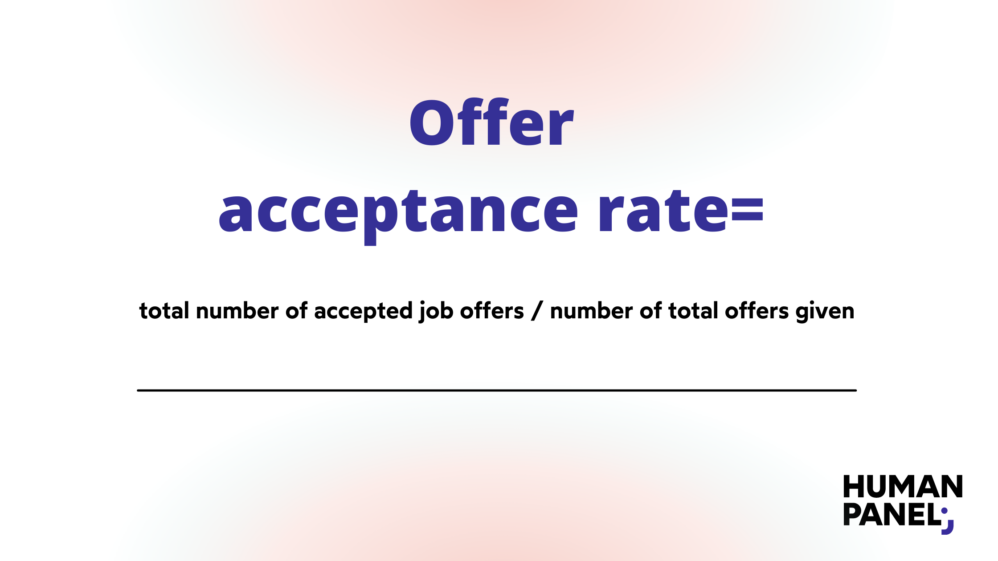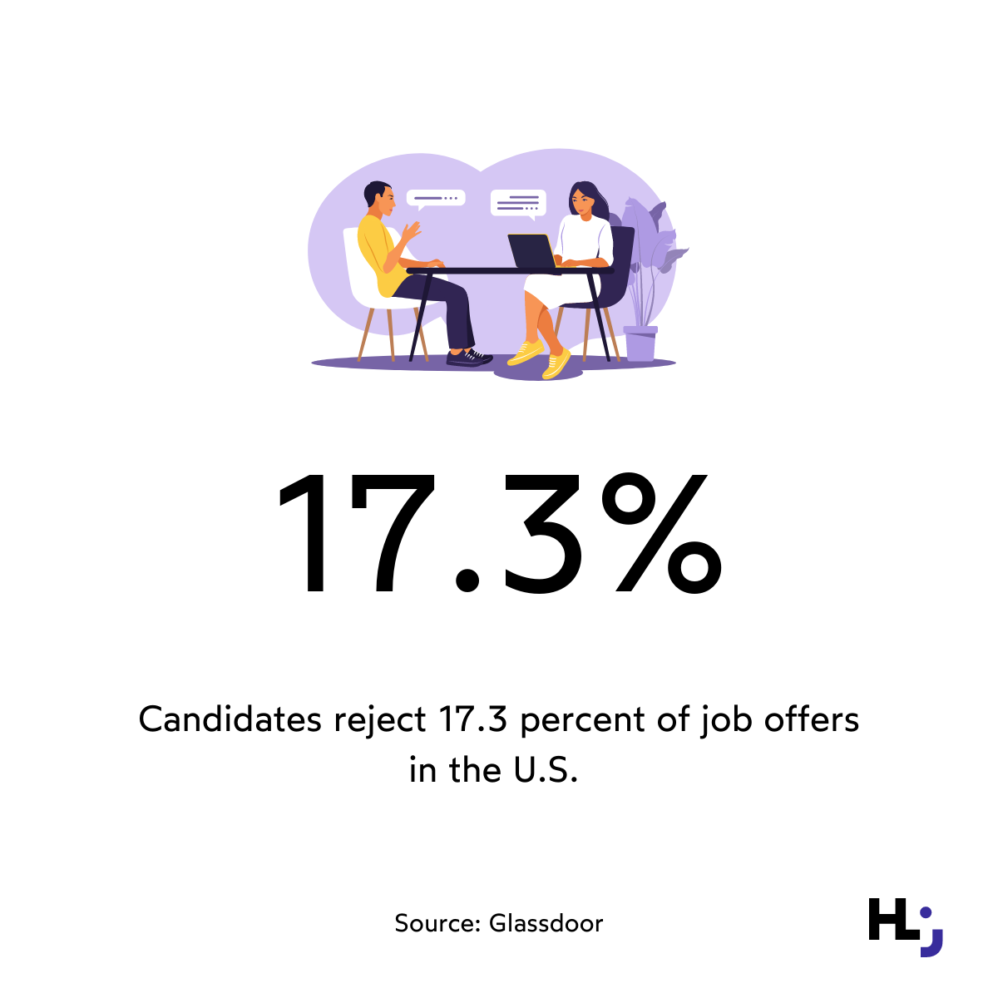5 verified steps to improve your offer acceptance rate

Have you ever found a perfect candidate for a job who rejected your offer at the last minute? Here is what you can do to improve your offer acceptance rate.
Offer acceptance rate is one of the most critical HR metrics in the hiring process and a key to the success of the company. The cost of hiring new employees increases every year, and the hiring process can be very time consuming.
Developing job descriptions, sourcing and selecting candidates, scheduling and conducting interviews all take time and resources and should result in you finding the perfect fit for the position and making an offer. But what if you find a suitable candidate, make an offer and get a “no” response?
Do not worry – it happens even to market leaders. In this article, you’ll learn what offer acceptance rate means, how to calculate it, and most importantly, how to improve it.
Offer acceptance rate – definition
Offer acceptance rate shows how many of the formal job offers were accepted by the candidates. It indicates how attractive and competitive your job offers are.
How to calculate offer acceptance rate?
To calculate the offer acceptance rate, take the number of accepted job offers and divide it by the total number of job offers submitted within a given time period.

Note that you should only consider final official offers to external candidates. Also consider how you collect data and whether you accept (or reject) a verbal acceptance.
Why is this metric important?
Companies want to achieve a high offer acceptance rate because they want to attract and hire the best possible candidates. Offer acceptance rate is an indicator of the effectiveness of the recruiting team and their ability to address candidate priorities and needs.
Recruiting is an expensive and time-consuming process. Every rejected offer incurs an additional cost to your company, and the cost of not considering qualified candidates is especially high. When a qualified candidate quits, it means you have to spend time finding another candidate, which means days, if not weeks, of additional work.
The biggest cost of hiring is the cost of a missed opportunity.
Simon Kubicki, Global Head of Talent Acquisition at Spendesk
The additional costs of high offer rejection rate include:
- the cost of vacancy
- the lost revenue
- the cost of staff
- the cost of recruiting
- the lost opportunity cost
- the competitive advantage cost
Reasons for low offer acceptance rate:
There are four main reasons of of the low acceptance rate:
- Lengthy recruitment process. If candidates wait too long to hear back from you, you may lose them to other companies.
- Lack of benchmarks for compensation and benefits. You need to offer a competitive salary and personalized benefits to attract the right talent.
- An overall bad experience for candidates. These days, employers need to treat candidates almost like customers and present themselves in the best possible light.
- Incorrect data. Some employers do not collect the right data points and do not realize the acceptance rate is too low until after the initial calculation.
Market benchmarks
The average offer acceptance rate is currently 64%, which means that about 64 out of 100 offers are accepted (source: Lever Talent Benchmark Report). Much depends on the industry and country, of course. In high-demand industries OAR falls down to 50%, as candidates have other jobs in sight.
A recent study published by Glassdoor shows that applicants in the U.S. reject 17.3% of job offers – more than 1 in 6. This rate has trended upward from 15.9% in 2015. This means that the hiring environment is fiercely competitive and that the “war for talent” could be real.
For the highest performing companies, the offer acceptance rate is 90-95% (source: PageUp). The best companies in the world, like Google or Facebook, even reach 100%.

Five ways to improve your offer acceptance rate
What can you do to improve your offer acceptance rate? Let us focus on this topic for a while.
Easy and smooth application process
There are still many companies that make the hiring process difficult and unappealing by using complicated application forms and asking overly personal questions. The applicant’s journey should be seamless and intuitive. Do not wait too long before reaching out to the candidate, and contact your potential employees directly after they apply for the job and provide feedback. It’s also important to be open and flexible when it comes to scheduling the interview.
Read also: How Tidio uses data to recruit IT talent?
Positive candidate experience
Take care of all interactions between you and your company with the job seeker throughout the hiring process. These interactions can include any communication a candidate receives by mail, phone, or in person. Even automated system messages count! A positive candidate experience does not mean the recruiting process is not demanding – it means you are developing good feelings about your company and encouraging your employees to share those feelings with others. Bad candidate experiences (recruiters showing up late for interviews, lack of feedback) can seriously tarnish your image as an employer.
Read also: Why candidate experience matters in talent acquisition?
Clear expectations
Be fair about what the candidate should know in order to get the job. Honestly talk about work hours, commutes, and scope of duties. Describe the intended team and current employees. Mention the onboarding and learning process. The more your candidate knows, the better. Research shows that the interview has a significant impact on an applicant’s decision, as it is often the first meaningful face-to-face interaction with a potential future employer. It also provides valuable information about company culture and career opportunities.
Read also: 10 tips to hire the right employee
Fair compensation
Salary and benefits are often considered the main reason a candidate is motivated to apply for the job. Compare yourself to the market and offer compensation that is competitive for the position and industry. Make sure the candidate is aware of the salary and benefits from the beginning and that the terms are acceptable to them. The sooner you reach an agreement in this area, the more likely the offer will be accepted.
People analytics
If you want to make better hiring decisions, do not rely on your ‘gut feeling’. Gather the data and measure the indicators relevant to the hiring process. Many recruiters still rely on instinct when making hiring decisions, while simple HR analytics can improve many other HR processes in your organization. If you are struggling to get started, we can help here at Human Panel. With our people analytics platform, you can measure offer acceptance rates as well as resignation and rejection rates at every stage of the hiring process.
See what other HR metrics you can track with Human Panel. Sign up for our free demo and see what we can do for you and your company to improve the efficiency of your recruitment funnel. Track offer acceptance rate, resignation and rejection by stage, time to hire and many other HR metrics.
Ready to start people analytics with Human Panel?
Other HR metrics that can help you with recruitment:
Application completion rate
The ratio of applications submitted to the total number of applications started.
Applications per opening
The number of applications per vacancy.
Candidates per hire
The number of candidates interviewed before one is hired.
You can also download a high-resolution Recruitment Metrics Cheat Sheet.



